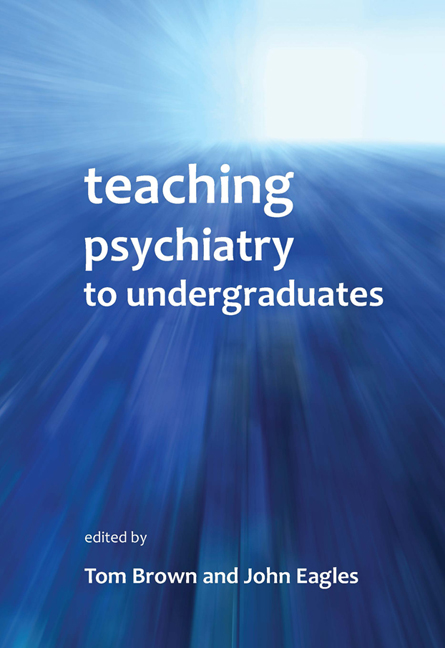Book contents
- Frontmatter
- Contents
- List of figures, tables and boxes
- List of contributors
- Preface
- Foreword
- 1 How do students learn?
- 2 Recent developments in undergraduate medical education
- 3 Undergraduate psychiatry teaching – the core curriculum
- 4 The organisation of undergraduate teaching
- 5 Assessment of undergraduates in psychiatry
- 6 Using computers to teach undergraduate psychiatry
- 7 How to give a lecture
- 8 How to do small-group teaching
- 9 Problem-based learning
- 10 Teaching trainee psychiatrists how to teach medical students: the Southampton model
- 11 Involving trainees in teaching
- 12 Involvement of service users in psychiatric education
- 13 Time-efficient clinical teaching
- 14 Intercalated degrees
- 15 Undergraduate experiences of psychiatry: a student view
- 16 Integration: teaching psychiatry with other specialties
- 17 Teaching the teachers in a cross-cultural setting: the Scotland–Malawi Mental Health Education Project
- 18 International undergraduate teaching
- 19 Teaching with simulated patients and role-play
- 20 Undergraduate medical education and recruitment to psychiatry
- 21 Choosing psychiatry: factors influencing career choice among foundation doctors in Scotland
- 22 Funding of the teaching of medical undergraduates
- 23 Dealing with students in difficulty
- 24 Training medical students to promote good mental health in secondary schools
- 25 Women in medicine
- Index
2 - Recent developments in undergraduate medical education
- Frontmatter
- Contents
- List of figures, tables and boxes
- List of contributors
- Preface
- Foreword
- 1 How do students learn?
- 2 Recent developments in undergraduate medical education
- 3 Undergraduate psychiatry teaching – the core curriculum
- 4 The organisation of undergraduate teaching
- 5 Assessment of undergraduates in psychiatry
- 6 Using computers to teach undergraduate psychiatry
- 7 How to give a lecture
- 8 How to do small-group teaching
- 9 Problem-based learning
- 10 Teaching trainee psychiatrists how to teach medical students: the Southampton model
- 11 Involving trainees in teaching
- 12 Involvement of service users in psychiatric education
- 13 Time-efficient clinical teaching
- 14 Intercalated degrees
- 15 Undergraduate experiences of psychiatry: a student view
- 16 Integration: teaching psychiatry with other specialties
- 17 Teaching the teachers in a cross-cultural setting: the Scotland–Malawi Mental Health Education Project
- 18 International undergraduate teaching
- 19 Teaching with simulated patients and role-play
- 20 Undergraduate medical education and recruitment to psychiatry
- 21 Choosing psychiatry: factors influencing career choice among foundation doctors in Scotland
- 22 Funding of the teaching of medical undergraduates
- 23 Dealing with students in difficulty
- 24 Training medical students to promote good mental health in secondary schools
- 25 Women in medicine
- Index
Summary
Introduction
The curriculum is a dynamic process. A static curriculum is a sick curriculum (Abrahamson, 1996). The constant remodelling of the educational programme in response to educational developments, local needs and national policy is an ongoing necessity. In this chapter we shall look at five areas of undergraduate medical education where dramatic change has taken place in recent years – curriculum design, teaching and learning, student assessment, student selection and staff development – and we shall explore the reasons behind these changes.
Curriculum design
In this section we explain: (a) the introduction of newer educational strategies (developed in response to societal pressures and problems) within the undergraduate medical educational programme itself; (b) the recent move to outcome-based education; (c) how models of curriculum design have changed, adapted and developed over the past decades; and (d) how educational theory has influenced the structure of the undergraduate medical curriculum.
(a) Educational strategies
An educational strategy is the approach taken to teaching and learning in the curriculum. At the end of the Second World War, when the world had changed in so many ways, it seemed inappropriate to young doctors returning from the fighting to Case Western Reserve University in the USA that medical education should continue as before. They wanted to train better doctors and to train doctors better. The innovations produced by that group signalled the start of ‘ROME’ (World Health Organization, 1989), the Reorientation Of Medical Education, which spread throughout the world. There were many different educational strategies involved in ROME and the SPICES model of educational strategies (Harden et al, 1984) was developed to classify them. SPICES is an acronym for: Student centred; Problem based; Integrated; Community based; Electives and core; and Systematic. These aspects of educational strategy will be described below.
Student centred
In a traditional curriculum, the teacher and the institution are the focus for the teaching and learning; formal lectures and laboratory sessions dominate delivery. Involvement of students in the educational process within this model is minimal, leading to somewhat passive learning.
- Type
- Chapter
- Information
- Teaching Psychiatry to Undergraduates , pp. 10 - 25Publisher: Royal College of PsychiatristsPrint publication year: 2011



